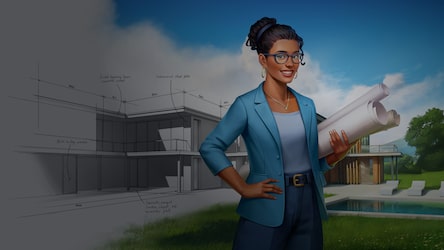Architect Interview Questions You Should Be Prepared to Answer
Architect Interview Questions You Should Be Prepared to Answer
Blog Article
Understanding the Diverse Job Paths Available for Aspiring Architect
As an ambitious Architect, you have a globe of occupation courses waiting on you. Each course supplies one-of-a-kind challenges and opportunities to apply your creative thinking and technological knowledge. Whether you're attracted to typical style or the nuances of lasting style, there's a specific niche that aligns with your interests. Understanding these diverse options can form your expert journey, yet which instructions will you select to explore initially?
Conventional Architecture: Designing Frameworks and buildings
Traditional design concentrates on creating structures and frameworks that mix performance with visual allure. Your styles can reflect cultural heritage, showcasing local traditions while satisfying contemporary requirements.
You'll create abilities in drafting, model-making, and site evaluation, permitting you to visualize and communicate your ideas successfully. Involving with clients, you'll need to understand their vision and equate it into viable layouts.
In addition, constructing codes and sustainability methods are necessary in your work, guaranteeing your frameworks are eco pleasant and secure. As you grow in your job, you'll find possibilities in domestic, business, or also repair projects, each offering unique obstacles. Embracing conventional style leads the way for a meeting job that pays homage to the past while shaping the future.
Urban Planning: Shaping Neighborhoods and Public Spaces
As a hopeful Architect, you can play a vital duty as a metropolitan planner, changing how communities connect and operate. By using neighborhood involvement techniques, you'll assure that citizens have a voice in shaping their setting. And also, incorporating sustainable design principles will help develop spaces that not just fulfill today's demands but also safeguard the future.
Role of Urban Planners
While lots of might assume of designers as the sole dreamers behind structures, city planners play an important duty in shaping the more comprehensive landscape of communities and public rooms. By collaborating with numerous stakeholders, you'll aid create parks, transport systems, and domestic locations that promote social interaction and access. Your knowledge in spatial design and community dynamics enables you to imagine future growth while maintaining social heritage.
Neighborhood Interaction Strategies
Reliable neighborhood involvement techniques are important for urban coordinators to assure that the voices of homeowners are heard and valued in the preparation procedure. To cultivate meaningful dialogue, you ought to focus on open forums and workshops where area members can reveal their concepts and worries. By proactively integrating and paying attention feedback, you'll produce rooms that mirror the community's needs, ultimately leading to even more effective and lasting urban settings.
Sustainable Layout Principles
When creating metropolitan areas, including sustainable style principles is crucial for producing settings that flourish both environmentally and socially. You need to begin by concentrating on power performance, making use of materials that reduce waste and advertise recycling. Consider incorporating green rooms, like parks and gardens, to enhance biodiversity and enhance air high quality. Promoting walkability and public transport can lessen dependence on autos, fostering a much healthier area.
Designing with water conservation in mind is also crucial-- consider rain gardens and absorptive surfaces to handle stormwater. Including community participants throughout the preparation procedure guarantees that the areas you develop fulfill their demands and encourage social interaction. By embracing these concepts, you'll contribute to vivid, lasting urban landscapes that benefit every person.

Landscape Architecture: Producing Lasting Outdoor Atmospheres
As you check out landscape design, you'll uncover necessary design concepts that produce beautiful and practical outside areas. Sustainable methods play a crucial role in ensuring these settings prosper while decreasing environmental influence. And also, you'll find a variety of job possibilities that allow you to make a genuine difference in exactly how individuals connect with nature.
Style Principles in Landscape
Recognizing design principles in landscape architecture is necessary for producing sustainable outside environments that harmonize with nature. You'll need to contemplate elements like equilibrium, scale, and proportion to guarantee your designs really feel natural and inviting. In addition, pay focus to seasonal adjustments, creating with materials that match the surroundings year-round.
Sustainable Practices Overview
Sustainable techniques in landscape architecture not only concentrate on aesthetic appeals but additionally focus on environmental health and wellness and resource conservation. By incorporating native plants, you boost biodiversity and lower the requirement for chemical fertilizers and chemicals. Applying effective watering systems assists preserve water and reduces runoff, shielding close-by ecosystems. You can create rooms that promote dirt health and wellness, such as exercising and using natural products permaculture principles. Additionally, incorporating environment-friendly facilities, like rainfall gardens and permeable pavements, help in stormwater management and decreases urban heat. When you create outdoor environments with sustainability in mind, you add to a healthier world and provide areas that cultivate community link. Inevitably, these techniques Find Out More ensure your layouts profit both people and the atmosphere for many years to come.
Job Opportunities Expedition
With a strong foundation in lasting methods, landscape style supplies a variety of occupation courses that permit you to make a meaningful influence on the atmosphere. You might work as a landscape developer, developing visually pleasing and practical outside spaces, or concentrate on eco-friendly restoration, helping to revive damaged environments. Urban planners typically work together with landscape designers to create eco-friendly rooms in metropolitan settings, boosting city livability. If you're passionate regarding education, think about ending up being a landscape architecture educator, motivating future generations. In addition, you could deal with nonprofits concentrated on ecological sustainability or engage in study to introduce new practices. Each course not just shapes lovely atmospheres yet additionally cultivates a healthier planet for future generations.
Sustainable Layout: Concentrating on Eco-Friendly Practices
As you explore your job in design, welcoming environment-friendly methods can set you apart in an affordable field. Lasting style focuses on developing structures that decrease ecological influence while enhancing passenger health. By integrating sustainable materials, energy-efficient systems, and lasting structure strategies, you'll contribute to a greener future.
Start by getting expertise of green certifications like LEED or BREEAM, which can boost your credentials. Consider exactly how all-natural light, ventilation, and thermal efficiency can maximize style. Team up with engineers and environmental professionals to innovate services that lower waste and save resources.
Do not neglect the importance of community participation-- interesting local stakeholders can motivate designs that integrate with the setting. As customers progressively focus on sustainability, your know-how in environmentally friendly methods will certainly not just attract tasks however also satisfy your passion for responsible architecture. Accept this crucial element of the profession, and watch your profession grow.
Historical Conservation: Safeguarding and Bring Back Cultural Heritage
While you commence on your architectural journey, consider the essential role of historic preservation in keeping our social heritage. This area concentrates on the security and restoration of substantial buildings, websites, and structures that tell the stories of our past. By involving in historical preservation, you'll assist protect the building tradition that shapes community identification.
As a historic conservation Architect, you'll examine historic value and assess the problem of structures. You'll function carefully with chroniclers and conservationists to ensure authentic restoration methods are utilized. This job course allows you to mix creativity with study, allowing you to make solutions that appreciate initial materials and workmanship.
Your work not only contributes to sustainability by recycling existing structures however likewise fosters a sense of satisfaction within neighborhoods. Embracing this path will certainly aid you become a guardian of history, protecting the tales and looks that enhance our lives.
Interior Architecture: Enhancing Indoor Spaces
Historical preservation and interior style both share a commitment to boosting the developed atmosphere, but they focus on different facets. While historical conservation emphasizes preserving a framework's historic and cultural value, interior style nos in on optimizing indoor spaces for capability and aesthetics.
As an ambitious Architect, you'll discover that interior design allows you to blend imagination with technological abilities. You'll create areas that not just look great but likewise advertise convenience and efficiency. This area includes recognizing how light, shade, and products engage within a space, influencing mood and usability.
You'll function on various jobs, from domestic homes to business look at more info offices, making sure that each atmosphere satisfies the demands of its passengers. By focusing on customer experience, you can change insides into motivating and practical areas, making a substantial effect on just how individuals communicate with their surroundings. Welcome the possibility to boost indoor environments and form the method people live and work.
Industrial Style: Combining Functionality With Looks
Industrial layout plays a necessary function in developing products that effortlessly mix looks with capability, guaranteeing that what you utilize day-to-day is not only visually enticing but also useful. As an ambitious Architect, you might engage yourself in this field, concentrating on developing whatever from furniture to customer electronics. Your work entails recognizing individual requirements, materials, and producing procedures, enabling you to develop ingenious options that enhance daily experiences.
In industrial design, you'll frequently team up with producers, designers, and marketing professionals, guaranteeing that your designs are not only stunning but additionally practical. You'll learn to balance kind and function, prioritizing usability without compromising style. By honing your abilities in sketching, 3D modeling, and prototyping, you'll be well-equipped to bring your ideas to life. This occupation course offers a dynamic environment where creativity fulfills functionality, making it a gratifying selection for engineers curious about shaping the items of tomorrow.
Often Asked Questions
What Educational Certifications Do I Required to End Up Being an Architect?
To become a designer, you'll need an expert degree in architecture, usually a Bachelor's or Master's. Additionally, you'll need to complete click to find out more an internship and pass the Architect Registration Exam to practice legally.
Exist Certification Demands for Different Architectural Career Paths?
Yes, there're qualification demands for numerous architectural courses. Architect. You'll require to pass examinations, complete internships, and sometimes seek specialized training, depending on your selected focus, like landscape design, city style, or historic conservation
What Software Skills Are Essential for Designers Today?

Exactly How Can I Gain Practical Experience While Researching Architecture?
You can obtain useful experience by interning at building companies, taking part in layout competitions, offering for neighborhood jobs, or collaborating with schoolmates on real-world tasks. These opportunities improve your skills and construct beneficial links in the industry.
What Work Opportunities Exist Outside Standard Style Firms?
You can explore numerous job chances outside typical architecture companies, like city preparation, interior decoration, landscape design, building and construction administration, realty advancement, and even duties in sustainability consulting. Each deals distinct difficulties and incentives.
Whether you're drawn to standard architecture or the subtleties of sustainable layout, there's a particular niche that straightens with your interests.When designing metropolitan rooms, incorporating sustainable layout principles is important for developing environments that flourish both environmentally and socially.As you discover landscape style, you'll uncover necessary style concepts that produce beautiful and functional outdoor areas.Recognizing layout concepts in landscape style is crucial for developing lasting exterior settings that harmonize with nature.In commercial layout, you'll frequently collaborate with marketing experts, suppliers, and designers, making certain that your layouts are not just stunning but additionally practical.
Report this page